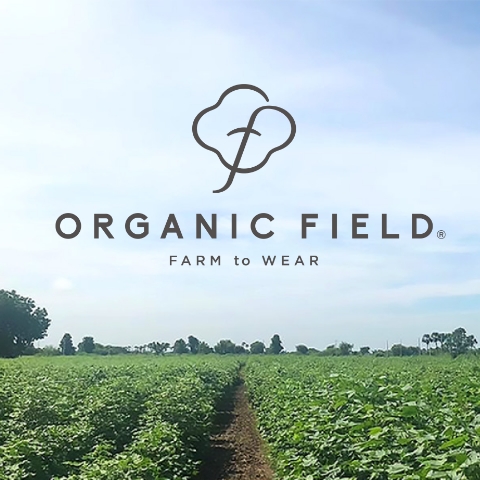
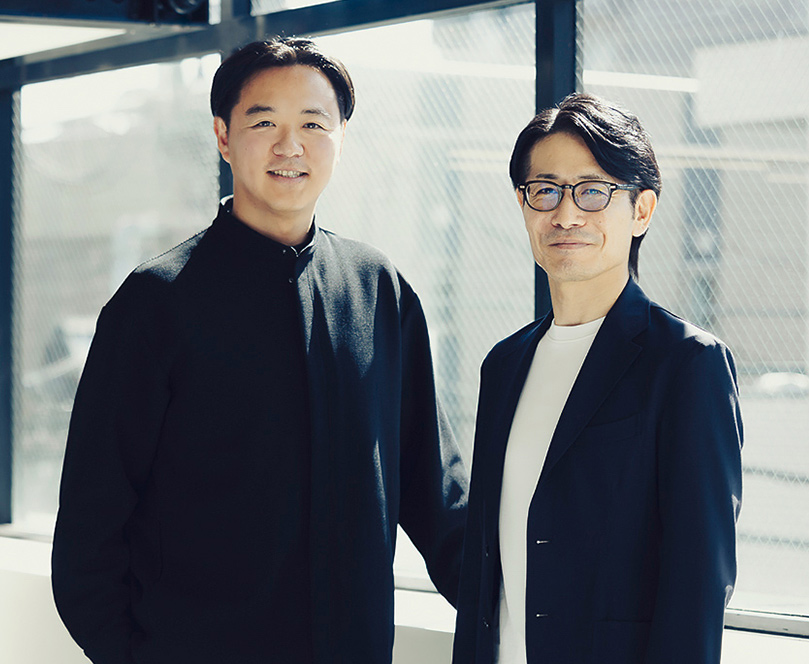
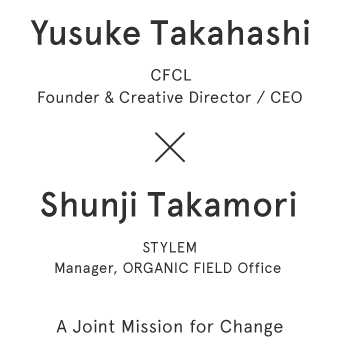
Yusuke Takahashi, Representative and Creative Director of CFCL, designs knitwear with a perspective — clothing as a tool for people living in everyday life. Shunji Takamori has spent 12 years living in India, working closely with cotton farmers and helping to build the foundation of ORGANIC FIELD. He now leads the project as part of the dedicated ORGANIC FIELD Office.
Together, they are working to share the values of ORGANIC FIELD with the world.
Cotton has a unique quality
that only natural fibers
can provide.
TakamoriWhile CFCL doesn't overtly promote itself as a sustainability-focused brand, it became the first Japanese apparel brand to earn B Corp certification — a recognition not only of its refined design but also of its commitment to transparency across the supply chain. We deeply resonate with CFCL’s values, and it was an honor for us to have ORGANIC FIELD adopted in your collection. That led us to initiate this conversation.
CFCL is known for its use of recycled polyester as a core material. What prompted you to start incorporating cotton?
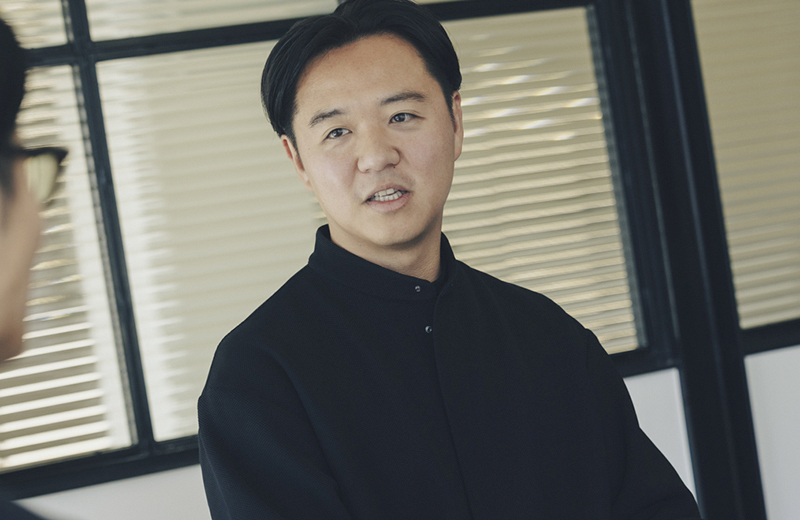
TakahashiAt the core of CFCL’s manufacturing is the use of computer programming-aided knitwear to create sophisticated clothing that suits all aspects of urban living. However, when relying solely on recycled polyester combined with knitting, we began to face limitations — both in terms of design and functionality.
We needed to explore other materials to bring in new textures and levels of comfort that polyester alone couldn’t offer. While cotton has a quality that can only be expressed in cotton, it tends to look too casual when used in knits, and our greatest challenge was figuring out how to maintain sense of elegance while using cotton.
After nearly two years of searching without finding a material we were satisfied with, we decided to take the initiative and develop it ourselves. That’s how we came to create a new yarn—one that blends recycled polyester with cotton, offering structure, breathability, and a sense of refinement.
TakamoriSo that’s how the original yarn was developed.
The best place to start LCA
is "at the farm."
TakamoriWhat led you to adopt ORGANIC FIELD for CFCL?
TakahashiAround 2018–2019, just before CFCL was founded, demand for organic cotton was rising due to the growing anti-plastic movement. At the time, sustainability efforts in cotton were actually more advanced than those in synthetic fibers.
After learning from you about ORGANIC FIELD — its mission and the work being done — I was truly impressed by the integrity of the project. In most cases, Life Cycle Assessment (LCA) is calculated using database estimates. But at CFCL, we try to pinpoint actual factories, check the types of electricity used, and measure environmental impact based on real data from production sites. Raw materials like wool or cotton are typically consolidated at one central location before being distributed and this makes traceability difficult. Especially in the case of organic cotton, it becomes even more concerning due to ongoing fraud issues.
So, although starting from seed selection and soil preparation requires more effort, we believe it's the most reliable approach. It’s just like rice or vegetables — when you know the farmers behind the product, the supply chain becomes more transparent, and that adds real value. I believe that same principle should be applied in the apparel industry as well.
Choosing not to use a material
simply because it lacks
certification
isn’t always the right approach.
TakamoriAs you’ve been working with ORGANIC FIELD, CFCL recently released a statement about "Cotton in Conversion" (hereafter referred to as "In-Conversion Cotton"). I imagine that many people weren’t familiar with the term. Have your thoughts or perceptions of In-Conversion Cotton evolved since then?
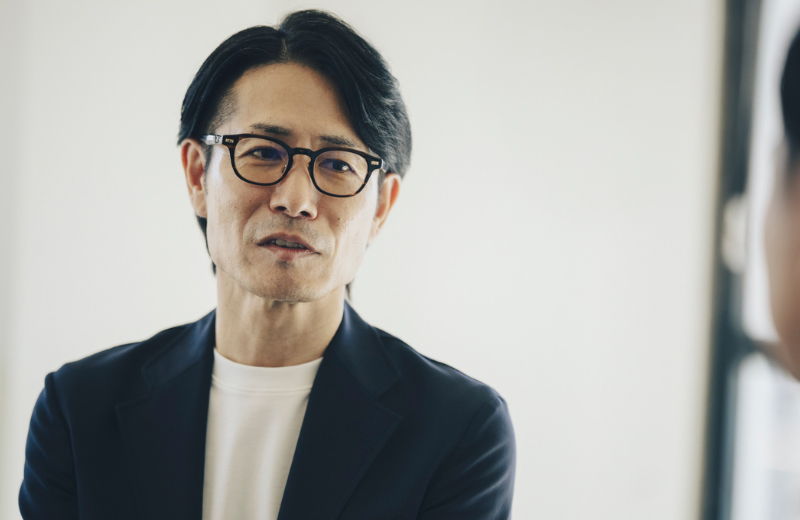
TakahashiYes, absolutely. To be honest, I wasn’t familiar with it either at first — and neither were most people in our company. While preparing for the release, we learned that the three-year transition period required to achieve organic certification is a major obstacle for farmers. That discovery prompted us to establish a clear stance internally: just because a cotton isn’t certified organic yet doesn’t mean it should be excluded as a material option.
TakamoriWas there any internal resistance to using In-Conversion Cotton because it lacks organic certification?
TakahashiCFCL has set a goal to use 100% certified materials by 2030, but from the beginning, our creative philosophy has centered on creating knitted garments with elegance. So, our priority is always to select the best material first — and if that material also happens to be certified, even better.
In-Conversion Cotton is eligible for OCS*certification, and when you understand the production background, it becomes clear that the lack of organic certification is not a reason to dismiss it.
What we value most is that we will have many more options for certified materials that are traceable and affordable. At CFCL, we continue using the same materials across seasons. That continuity strengthens relationships with suppliers, enabling natural conversations like: "We’ve been using virgin materials — could we develop a certified or recycled alternative together?"
When those needs become visible across the industry, more manufacturers begin to compete in developing such materials. That results in greater variety, more competitive pricing, and a broader market overall. CFCL may still be small, but I genuinely believe we’ve contributed to the growth of the recycled polyester market — and I believe we can do the same for cotton.
* OCS (Organic Content Standard) Certification: An international, third-party certification based on voluntary standards that verifies the production and processing of products containing organic fibers.
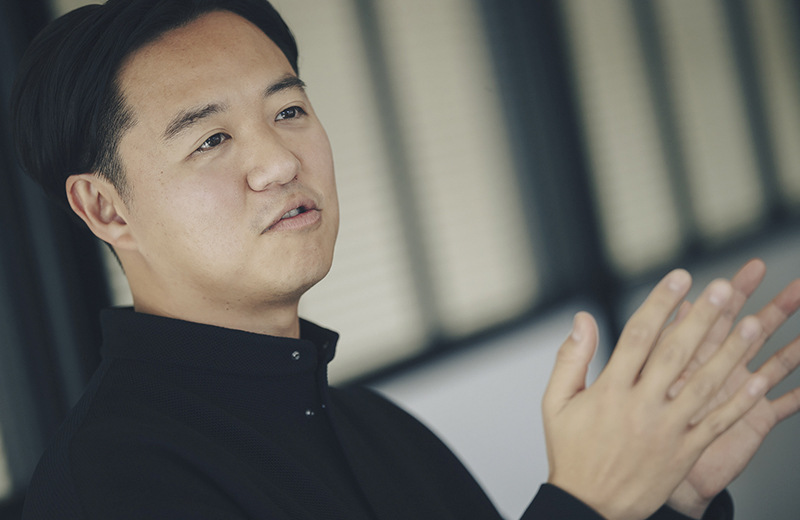
Brands have a responsibility
to connect producers
and consumers.
TakamoriThe original mission of ORGANIC FIELD is not simply to sell cotton — it's to expand organic farming itself. But here in Japan, awareness of In-Conversion Cotton remains low. It’s often dismissed outright as "not organic," which limits its access to the market.
That’s a serious challenge. Meanwhile, there are still many cotton farmers in India eager to join this project. Is there something we could do together with CFCL?
TakahashiI believe brands like ours have a unique role to play as a kind of media platform within the fashion industry, linking the upstream parts of the supply chain — like farmers and manufacturers — with end consumers. Unlike B2B businesses, brands engage directly with consumers, and there are countless brands, each with its own voice and audience. If we can harness that collective communication power, we can truly make an impact.
Taking part in interviews like this is part of that too. When I come across a project that I genuinely believe brings social benefit, I feel it’s our responsibility to communicate that message to consumers — to help inform, educate, and build awareness. Even small efforts like these can ripple outward. If our actions are picked up by industry media or shared through broader channels, they can play a meaningful role in helping more people understand the value of projects like ORGANIC FIELD.
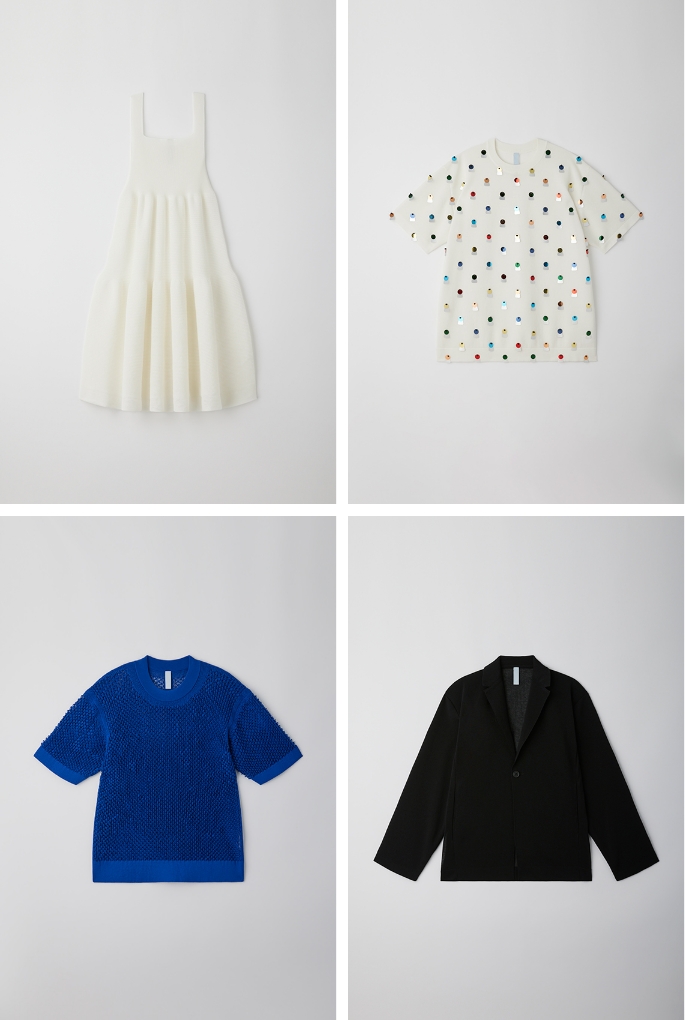
Products made with cotton from ORGANIC FIELD
VOL.9 Collection / CFCL
Our choices shape the future
of entire industries.
TakamoriAfter spending many years on the ground in India, I’ve seen firsthand the realities of cotton farming — the labor conditions, the challenges farmers face — and I feel a deep responsibility to share that with the world. If we can communicate those stories, I believe it has the power to spark change.
TakahashiI agree. Capturing the attention of consumers is incredibly important. For example, I’ve taken my 5-year-old daughter to visit silk farms so she can see how silk is actually made. I also explained to her that this garment comes from recycled plastic bottles, this one is made from wool, this one from cotton — helping her begin to understand where things come from. When children see the people behind the materials — like those who pick cotton — it leaves a lasting impression. It becomes something they remember, something that stays with them.
We’ve all heard about the recent spike in cacao prices. But what’s often overlooked is that many workers on cacao farms earn less than $2 a day, and some have never even tasted the chocolate they help produce. It’s important that I share these realities with my daughter, who loves chocolate, so she can understand the full story behind the things she enjoys.
Today, with the power of social media, personal messages — if they’re honest, meaningful, and grounded in truth — can spread faster than ever. We live in a world where a single video of a sea turtle with a plastic straw in its nose can lead to global action. People are beginning to understand that their individual choices can shape the future of entire industries — and I truly believe that too.
TakamoriThat’s exactly how I feel. I want to keep sharing the story of ORGANIC FIELD and cotton in conversion, and help raise awareness.
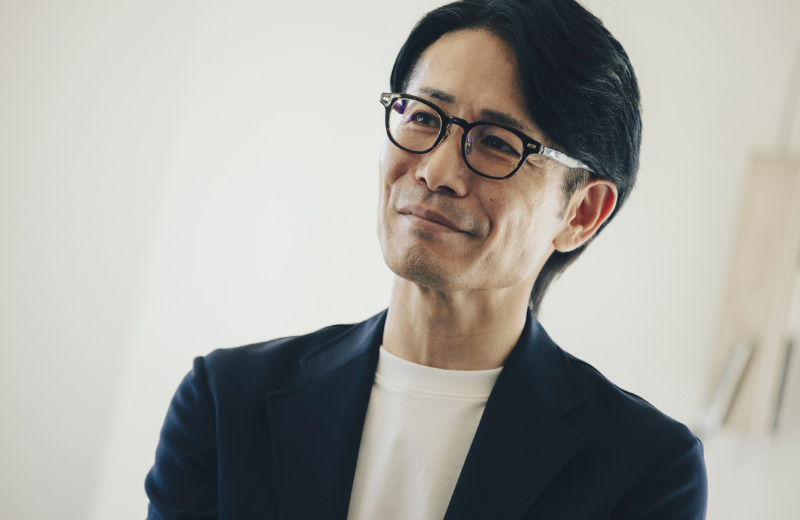
ORGANIC FIELD has the power
to transform the future
of global fashion.
TakahashiAs someone who works with a wide variety of materials every day, I’m reminded time and again that cotton is one of those essential fibers that will never disappear. It offers warmth, absorbency, and an inherent adaptability that responds to different environments. What excites me about ORGANIC FIELD is that it's not just about expanding organic cotton farms — it’s about how cotton can help reshape the future of the global fashion industry. When I think of that long-term vision, it gives me the energy to stay committed to the steady, behind-the-scenes work required to get there.
TakamoriI truly believe in the potential of cotton — and I want to help build that future together.
Toward the realization of sustainable fashion, I hope that initiatives like this will continue to grow, and I would like to steadily move forward day by day, one step at a time.

Founder & Creative Director / CEO
Born in Tokyo in 1985.
After graduating from Bunka Fashion Graduate University, he joined Miyake Design Studio in 2010, and was appointed as the designer of ISSEY MIYAKE MEN in 2013, leading the team for six years. After leaving the company in 2020, he established CFCL Inc. In 2021, he received the MAINICHI FASHION GRAND PRIX 2021 (the 39th), New Comer's Prize and Shiseido sponsorship Award, as well as FASHION PRIZE OF TOKYO 2022. With CFCL, he has been participating in Paris Fashion Week since 2022. In 2024, he was named one of the Vogue Business 100 Innovators: Sustainability Thought Leaders.
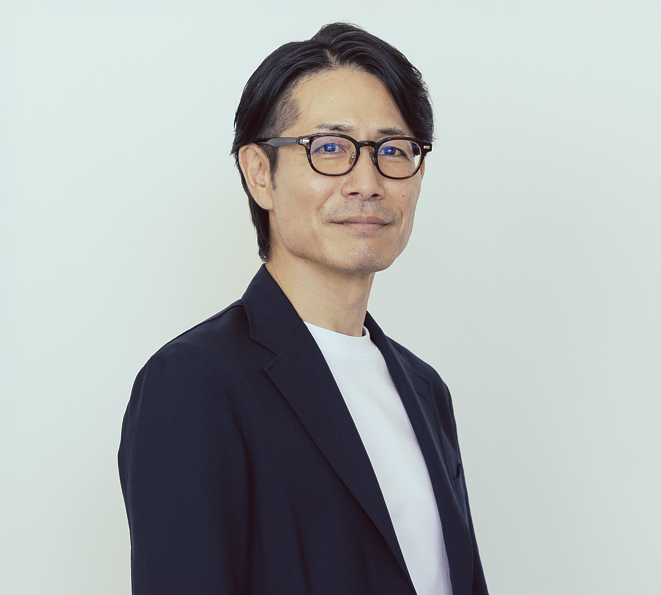
Manager, ORGANIC FIELD Office
Born in Osaka in 1976.
He joined TAKISADA-OSAKA (now STYLEM TAKISADA-OSAKA CO., LTD.) in 1999. For 13 years, he was engaged in textile sales, primarily within the Japanese domestic market. In 2012, following the establishment of the company’s local subsidiary in India, he began an overseas assignment there. In 2017, he was appointed President and CEO of the Indian subsidiary. He assumed his current position in 2024.
